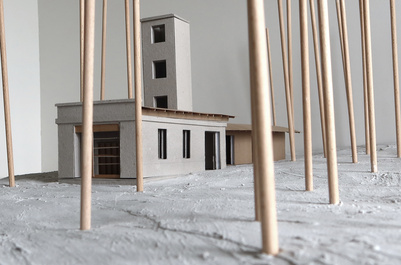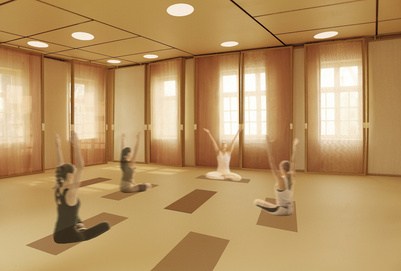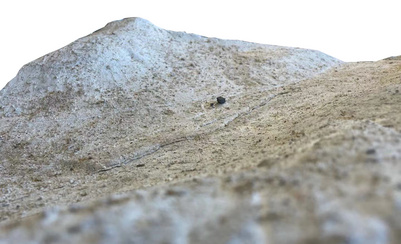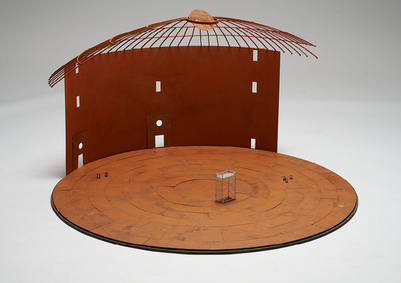Feminism, art, spiritism and the grandeur of nature unite in this project where a series of abandoned fortifications from WWII are transformed into inspiring spaces where artists can come to engage in mysterious methods derived from Swedish turn-of-the-century artist Hilma Af Klint.

Excerpt from report.
Abstract.
This project revolves around an artist residency for inspiration by the spiritist methods of Swedish turn-of-the-century abstract arstist Hilma Af Klint, within the shell of WWII fortifications located in a former artistis destination at Kullaberg peninsula, Sweden.
It is about transformation. Af Klint’s methods into spatial setting. Bunkers from former war monuments to a place for artists inspiration. The artist’s body to extended mind. Extending the fortification’s boundaries beyond thick concrete walls to include both site and spirit. The history of site, war times and women’s struggle for independence always present. Designing through atmosphere and sensory experience, considering the delicacy of the spiritual activities which will take place within the frame.

Excerpt from report.
Introduction.
In a past era, artists sought out to the dramatic landscape of Arild, north west of Skåne, Sweden. From middle of the 19th century onwards they travelled here to take inspiration from the unique landscape and atmosphere (Robild, 2014, 186-191). From this stems Arildsgruppen, an organized group of artists who during the years developed into an extensive network for sharing, creating and knowledge spreading through the country. The steady stream of visiting artists gradually waned and even though the group made an attempt in the 60s to revive the former thriving artist life in Arild, it seems there was no true success (Magnusson, 2013). Today, a few artists are settled here more permanently and the annual spring art exhibition Konstrundan2 has an important base in the area (Nordvästra Skånes Konstnärsförening, n.d.), but the idea of artists traveling here for work and inspiration is not as established as a phenomenon to this day. As general tourism grew stronger and prices for plots by the sea increased, perhaps the circumstances have made it difficult for such a movement to reform spontaneously.



MOTIVATION
Other than being a location for artists inspiration, site holds stories of mysticism, elves and forest gods (Robild, 2014, 7). It has historically evolved much due to women of the village who stayed when the men were at sea (Arilds Byalag, u.d.). The village community website states that the history of Arild belong to the women (Arilds Byalag, u.d.), describing them starting enterprises and making the village thrive. Aside site with its unique atmosphere and history, I have a motivation relating to site through that spiritual nature and history of strong women making a difference. In prior semester project, I addressed the world of then-contemporary Swedish abstract artist Hilma af Klint (1862–1944) through the eyes of the child, same site. focusing on truly engaging with children early in the design process, to develop a spatial translation of Af Klint’s art by play and tactility. In this thesis project I leave the focus of codesign and children and instead bring Af Klint with me to explore the possibilities that her very methods holds and what spatial outcome could accommodate those in the context of an artist residency at said site2. Contemporary occult artist Ithell Colquhoun has described such methods as a medium through which artists will reveal the deeper streams of fantasies and how this uncontrolled state of creation will lead to a controlled active creation in the further artistic process. She also stressed the importance of these as a way to create a more egalitarian space where female artists could explore the higher self, granting them access to a less controlled expression of their art as part of liberation from the patriarchy (Tessel M. Bauduin, (Hilma af Klint, konsten att se det osynliga, 2020, 143-153).
THESIS STATEMENT
Considering atmosphere and qualities of site, the spiritual methods as conceptual foci and the history of artists dwelling here, my direction for this project will be to develop an inspirational artist residency program in Arild, Sweden, in order to reawake the dormant artistic inspirational power that the area holds.
ELABORATION
As placeholder for the residency I’ve centered the project around concrete fortifications from the 40s found at site. To re-purpose these abandoned homogenous monolith military monuments into serving as a frame to hold another kind of reality, to be an amplifyer to an inspirational spiritist session. The project will tend to the possibilities and limitations of the selected bunkers, surrounding qualities, history and area’s unique character alongside spatial and atmospheric factors to suit the respective selected method.
Through this program, I aim to develop a novel setting for such an exchange of inspiration historically sought by visiting artists. The program would offer a possibility to explore a perhaps unknown way of approaching one’s creative process by highlighting the unique artistry and methods of Af Klint. It could offer an element of novelty for artists who seek inspiration, who are eager to explore and expand in their artistry.
The larger area is evolving constantly and while focus seem to be much about tourism through food, nature and local craftsmanship, this program could contribute to a stronger cultural relevance.


Excerpt from report.
Description of methods.
MEDITATION . As basis, meditation is commonly used before attempting to perform either method. Its purpose is to clear the mind, set intentions and tune in to the esoteric; mind rather than body, intuition over reason. Af Klint often meditated in solitaire, but The Five meditated together before séances as well. By deep meditation they were able to put themselves into trance, a self-hypnotic state of mind.
Description of method: Usually one would sit or lie down comfortably, relaxing the body and mind, focus on the breathing. Eyes can be closed or open, gaze towards one point. As it can be difficult for a beginner to fully let go of controlling the mind, enhancers can be used to help, such as scent, sound or a calm environment. The importance of letting thoughts and mental images come and pass without judging or controlling the stream is key in a meditation session. This blissful superconscious state is often referred to as samadhi in yogic context (Yogananda, 1946, 123).
AUTOMATISM . Automatism was a frequent technique among surrealists in the 1920s, in order to minimize the controlled within the creation of art, particularly in the initial creative phase. Even composers and photographers have actively used automatism, though through their own techniques as in Man Ray’s rayograph, where objects were placed on photographic paper in order to create a negative of the object by chance (Tessel M. Bauduin, (Hilma af Klint, konsten att se det osynliga, 2020, 126-132). Af Klint similarly used this method to liberate herself from previous education and constraints, but also as a tool to communicate that what she spiritually experienced while in trance. When performing this session as part of The Five, all drawings would be signed by group initials regardless who was holding the pen (Faxneld, 2020, 167).
Automatism frees the artist from current constraints that the psyche has over reason, moral, society and above all; the artistic education (Tessel M. Bauduin, (Hilma af Klint, konsten att se det osynliga, 2020, 132).
Description of method: After meditation, the artist will hold a pen towards a blank sheet of paper and let the hand move over the paper freely. The artist would act as a channel without thinking or controlling the pen. Typically, the pen would rarely be lifted from the paper, creating characteristic flowing lines which are open to interpretation. The outcome of this session could be written words or letters, or more towards drawing. Whatever comes out of it would later be used as a basis for further creation of the art piece itself. As this is the more common way of automatism, there should be reason to think that it could be used in another context as well, such as through music, dancing or 3 dimentional automatism.
NON FIGURATIVE INTUITIVE . During the latter part of Af Klint’s artistry, inspired by Steiner’s anthroposophy, she had non-figurative, intuitive sessions portraying the energy and aura of a (often botanical) object. This marks out a shift in expression from the more geometric to a more non controlled flowing expression (Iris-Müller Westermann, (Hilma af Klint, konsten att se det osynliga, 2020, 164). In theosophy, aura is explained as parapsychological eva-poration and even Piet Mondrian created paintings portraying plants with some sort of energetic shape stretching beyond the physical. Botanical symbolism within spiritism was common (Faxneld, 2020, 61-64), also seen in many of Af Klints abstract paintings. Botanic motifs were popular at this time even outside of spiritism, though focusing on the very esoteric within the plant itself was not as common (David Lomas, (Hilma af Klint, konsten att se det osynliga, 2020, 174-177).
Description of method: After meditation the practitioner observe an object for a long, uninterrupted period of time. By this, the artist might start perceiving things beyond the obvious and perhaps visible. The artist could note the object’s small details, the connections between different parts of the object or the smell or sound of it, all which portrays the essence of the object rather than just the visual (this ties to the phenomenological approach described by i.e. Pallasmaa in various books) This could be expressed via, like Af Klint, water colour technique where she worked with pencil on damp paper letting the colours blend into one another (Faxneld, 2020, 175), or by moving the body freely if the artist were a dancer, intuitively create sound if the artist is a musician. The material would later be used as a basis for creation of the respective piece.
GROUP SÉANCE. This method was key for The Five and could be performed as an independent session or in combination with i.e. automation. The difference between meditation and séance is that meditation has a purpose of putting oneself at a meditative state (here used as a preparatory tool) where séance has a purpose of channelling whatever the participant perceives while in direct contact with the higher spirits, spirit world or higher self during a trance like state (Müller-Westermann & Høgsberg, 2020, 26-29).
Description of method: The session would preferably start with a group meditation where the participants come together in a joint calm state of mind. After this, the participants would normally sit in a circular formation for the chanelling. One participant would be in charge of documenting the session by notebook. Either of the participants would then receive whatever mental image, message, sense, smell or other esoteric experience that would appear. Key in this session is the collective meditative state, where all participants contribute to the session whether receiving message or simply be a passive amplifier of atmosphere.























